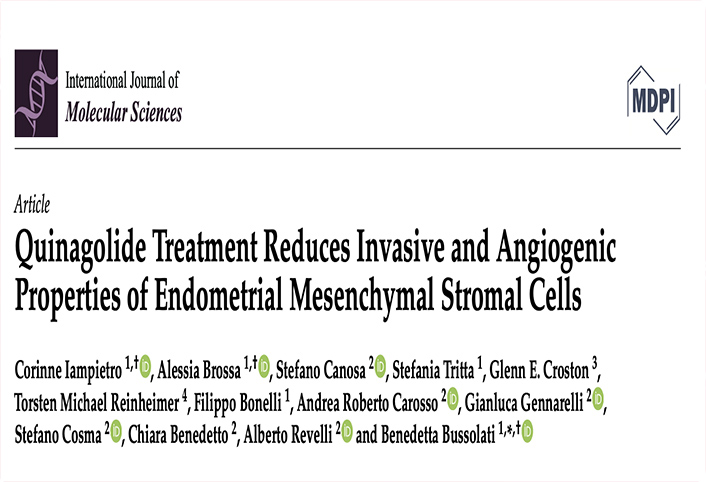

Corinne Iampietro, Alessia Brossa, Stefano Canosa , Stefania Tritta, Glenn E. Croston, Torsten Michael Reinheimer, Filippo Bonelli, Andrea Roberto Carosso, Gianluca Gennarelli, Stefano Cosma, Chiara Benedetto, Alberto Revelli and Benedetta Bussolati
Int. J. Mol. Sci. 2022, 23(3), 1775; https://doi.org/10.3390/ijms23031775 – Received: 30 December 2021 / Revised: 27 January 2022 / Accepted: 2 February 2022 / Published: 4 February 2022
Abstract
Endometrial mesenchymal stromal cells (E-MSCs) extensively contribute to the establish- ment and progression of endometrial ectopic lesions through formation of the stromal vascular tissue, and support to its growth and vascularization. As E-MSCs lack oestrogen receptors, endometriosis eradication cannot be achieved by hormone-based pharmacological approaches. Quinagolide is a non-ergot-derived dopamine receptor 2 agonist reported to display therapeutic effects in in vivo models of endometriosis. In the present study, we isolated E-MSCs from eutopic endometrial tissue and from ovarian and peritoneal endometriotic lesions, and we tested the effect of quinagolide on their proliferation and matrix invasion ability. Moreover, the effect of quinagolide on E-MSC endothe- lial differentiation was assessed in an endothelial co-culture model of angiogenesis. E-MSC lines expressed dopamine receptor 2, with higher expression in ectopic than eutopic ones. Quinagolide inhibited the invasive properties of E-MSCs, but not their proliferation, and limited their endothelial differentiation. The abrogation of the observed effects by spiperone, a dopamine receptor antagonist, confirmed specific dopamine receptor activation. At variance, no involvement of VEGFR2 inhibition was observed. Moreover, dopamine receptor 2 activation led to downregulation of AKT and its phosphorylation. Of interest, several effects were more prominent on ectopic E-MSCs with respect to eutopic lines. Together with the reported effects on endometrial and endothelial cells, the observed inhibition of E-MSCs may increase the rationale for quinagolide in endometriosis treatment.